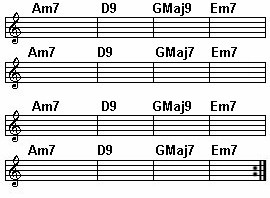Scroll through the lesson and click on notation/video/audio links to load the interactive players.
Please subscribe to get full access to all lessons for only $7.95/month PLUS 1 week free trial.

Riff Interactive lessons are
LESS expensive and
MORE interactive than alternatives!
More Info
|
|

Jazz Guitar For
Beginners
Lesson 8
Lyle:
This lesson will teach you many new ways to play a simple chord progression, and
those little jazz riffs you hear in the lesson sample.
Lyle: First, look at this chord
chart:
chord
chart

Lyle: It's almost a repeating 4 bar
progression.
Lyle: The GMaj9 is replaced with a GMaj7 every
other time.
Lyle: Then you repeat after 8 bars. But you are
going to learn how to play a descending chord progression for all 16
bars.
Lyle: Listen again to the chords in the lesson
sample and you'll hear them start high and end up down
low.
Lyle: This is a basic II-V-I-VI chord progression
in G.
Lyle: The object is to hold every note of the
chord as long as possible, moving fingers only when absolutely necessary to
arrive at the next chord.
Lyle: You're going to learn this progression 4
bars at a time.
Lyle: Here's your jam
track:
Lyle:
Many of these chords are tricky because they don't have a root note in them or
they don't have them in the bass. These will all be 4 string chords. Here's the
first group:
Lyle:
Learn those 4 chords and practice playing them along with the jam
track.
Lyle: Here's the next group of chords for bars 5
thru 8:
Lyle: ....and I've circled the root notes that
are in some of these chords:
Lyle:
Memorize this group of chords and try playing them along to the looping jam
track.
Lyle: Then see if you can play chords 1 - 4 and 5
- 8 all together.
Lyle: These are good finger exercises. No
stretching involved but still good for your fingers.
andres: What
would this progression be called, II V I ?
Lyle:
II-V-I-VI
Lyle: Here's the next group of
chords:
Lyle:
Now practice this group of chords with the jam track.
Lyle: Next is the last group of
chords:
Lyle: No
fancy chord names, just a bunch of ways to play these basic chords. Now try
putting them all together. Here's all 16 bars and chords. I grouped them into 2
chords per bar in this next TAB only to make it a little easier to
read>
Lyle:
That should keep you busy for awhile....
Lyle: The little solo in the lesson sample is
made in the key of G Major.
andres: Is there a way to remember this trick in all
situations, like if I was playing a blues
progression?
Lyle: Lots of practice.
andres: :), isn't there an operation I can get
instead?
Lyle: Substitute any of these chords into your
blues or any other progression.
Lyle: Here's the scales and patterns I used to
make the solo in the lesson sample:
LiveOak:
Oooh... LOVE those double stops :))
Lyle: This next one is the Bb Minor pentatonic,
great to use over the D9 chord only.
Lyle:
Very simple scales and patterns.
Lyle: Here's how I used them to make the solo
from the lesson sample:
Greg: It's amazing the range of licks you can get with a few simple
scales!
Lyle: Yes, that's why it 's so important to learn
your basic scales like all your Majors and Minors.
Lyle: A plain scale can be used in so many ways,
it's hard to say just one or two ways.
Lyle: Like the Bb Minor pentatonic I used over
the D9 chord, you wont find that in most lesson books!
Lyle: Good luck on this lesson. Try to get all
the chords down. It will be a small challenge for some tougher for others, and
easy for some.
Lyle: The Bb Minor pentatonic provides all the
altered tones not found in the key of G Major. So when played against the D9
dominant chord it creates altered tones, giving you blues and outside
sounds.
radica:
I like that one the best as well.
Lyle: Time for me to take a break. See you again
soon!
|
<< load notation from left
|
|
<< load audio from left
|
<< load audio from left
|